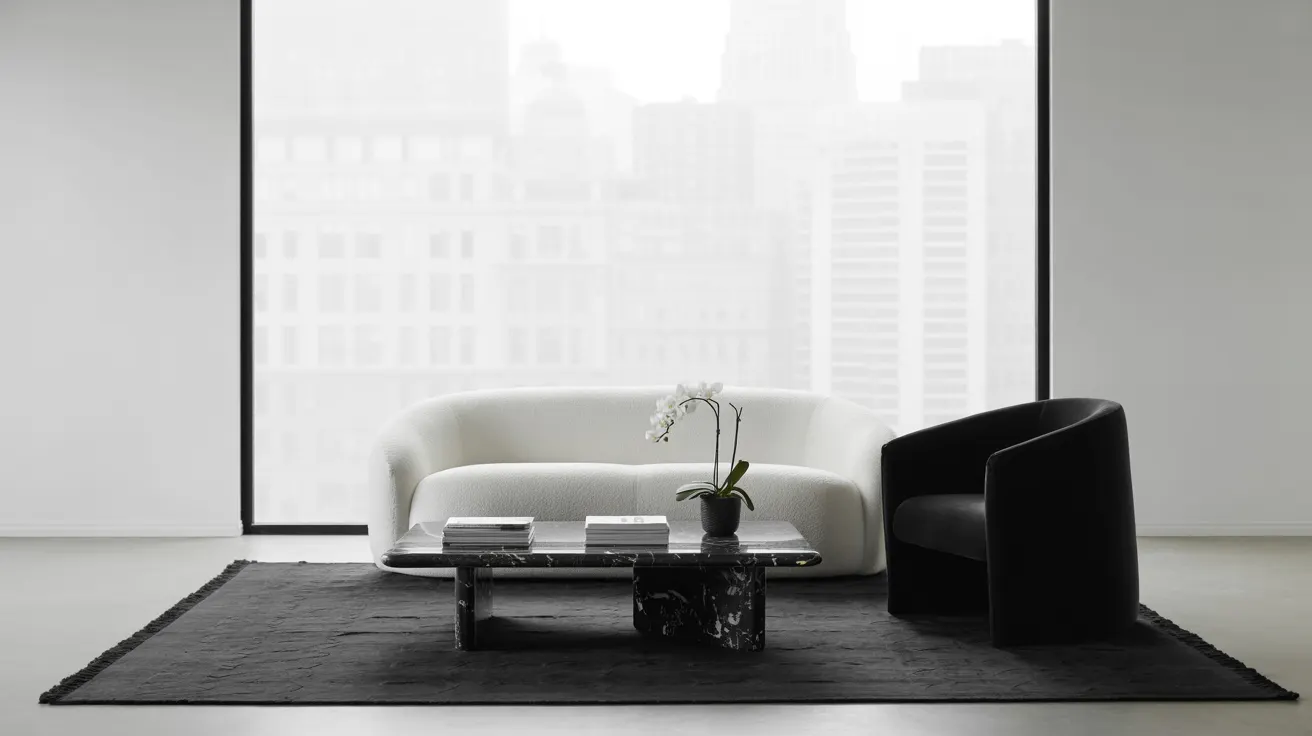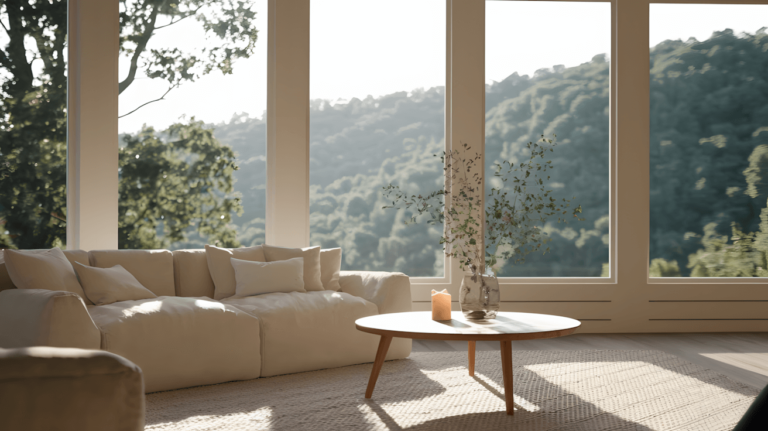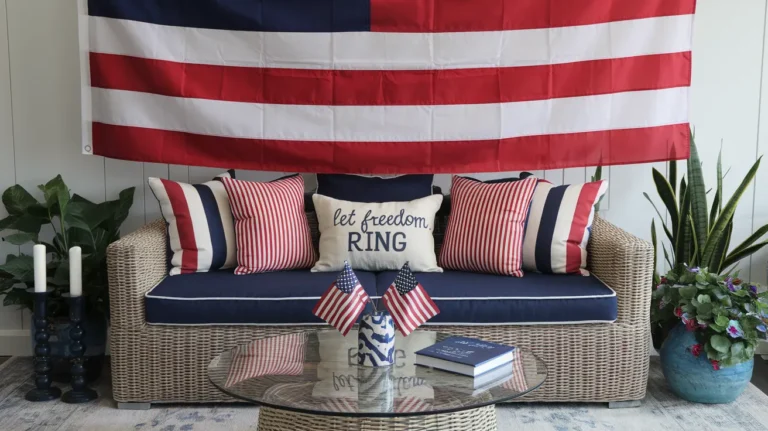Some color schemes come and go (remember avocado green and harvest gold?), but black and white remains the ultimate power couple in home design. There’s something undeniably striking about this classic duo that manages to feel both timeless and completely of-the-moment.
I’ve been slightly obsessed with black and white living spaces lately—my Pinterest boards are proof—and I’m convinced it’s one of the most versatile palettes you can choose. Whether your style leans minimalist, maximalist, or anywhere in between, black and white provides the perfect backdrop for creating a space that’s uniquely yours.
Let’s dive into some gorgeous black and white living room ideas that might just convince you to embrace this high-contrast look in your own home.
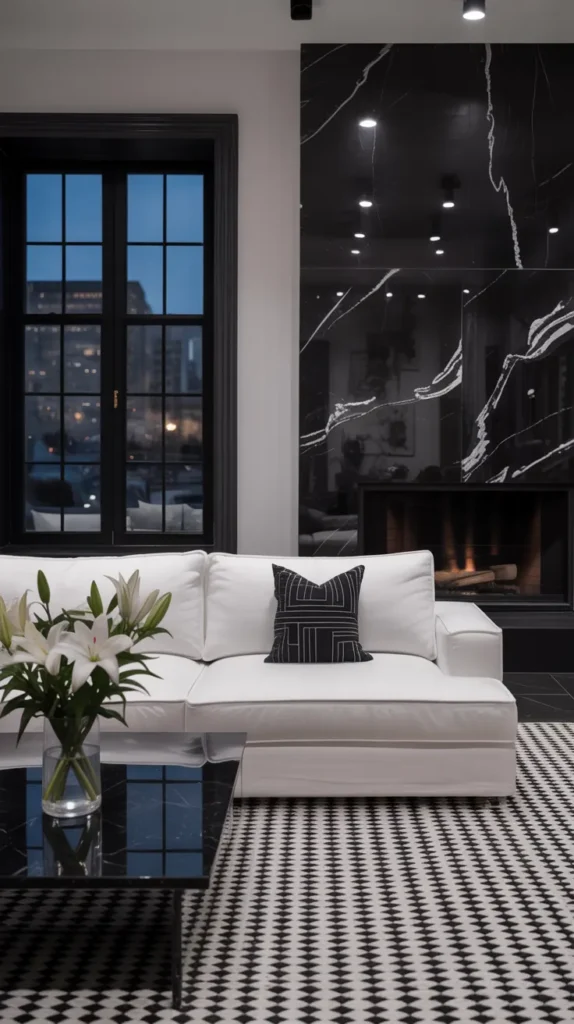
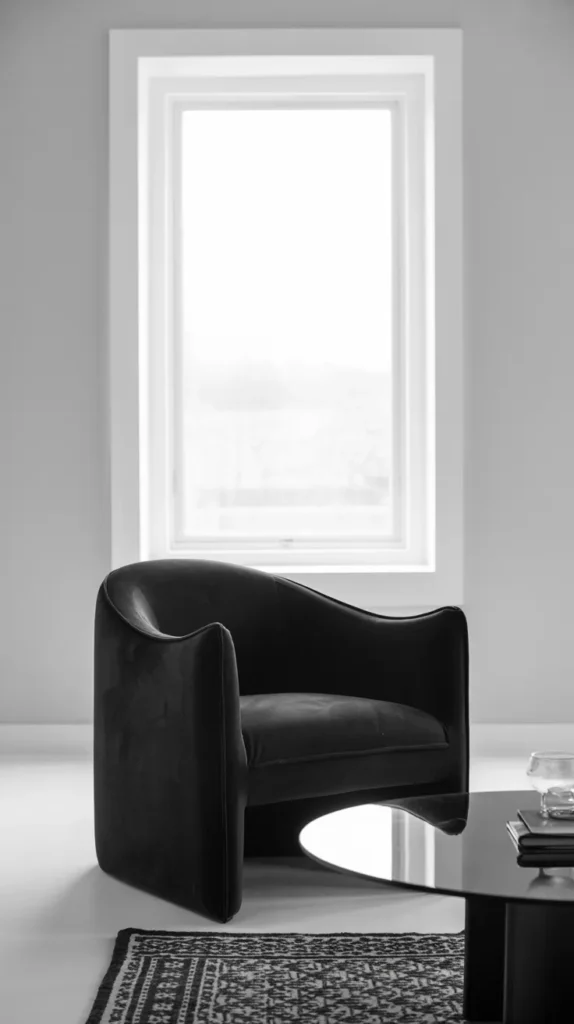
Why Black and White Never Goes Out of Style
Before we jump into specific design styles, let’s talk about why black and white has such enduring appeal. This isn’t just another trend destined for the design history books—it’s a classic approach with serious staying power.
What makes black and white so magical is its:
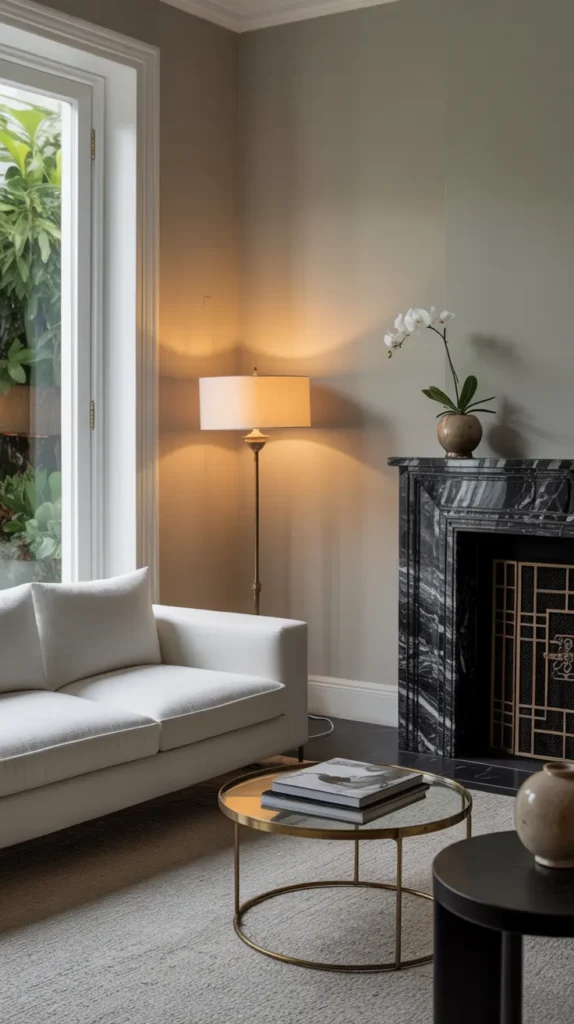
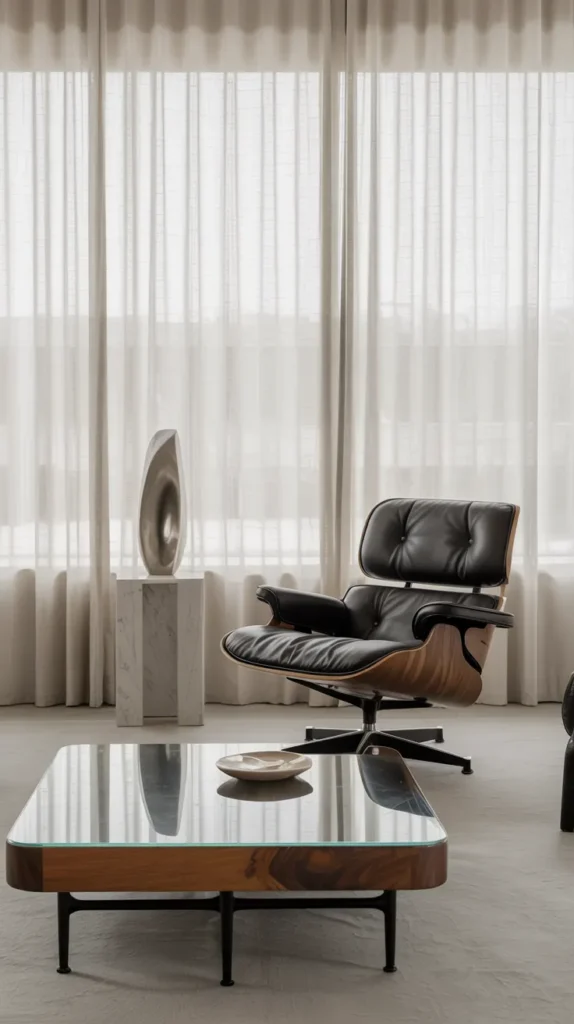
- Versatility: It works with literally any design style, from ultra-modern to French country
- Sophistication: There’s an inherent elegance to high-contrast spaces
- Flexibility: It creates the perfect neutral canvas for introducing other elements
- Drama: Even the simplest room has visual impact with this color scheme
I’ve found that black and white spaces are also incredibly practical. They make decorating decisions simpler (will this go with my color scheme? If it’s black, white, or something in between, then yes!), and they’re easy to update when you’re ready for a change. Just swap out a few accessories, and you’ve got a whole new look without repainting or buying new furniture.
Getting Started: How to Incorporate Black and White Without Going Overboard
If you’re new to the black and white game, diving in can feel a bit intimidating. The key is finding the right balance for your space and comfort level.
Here’s how to ease into this high-contrast look:
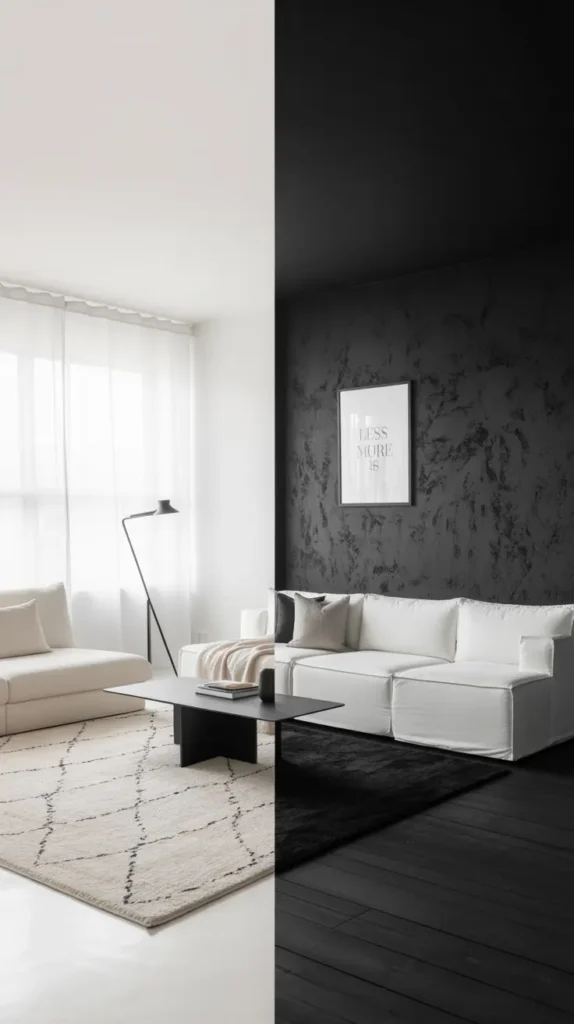
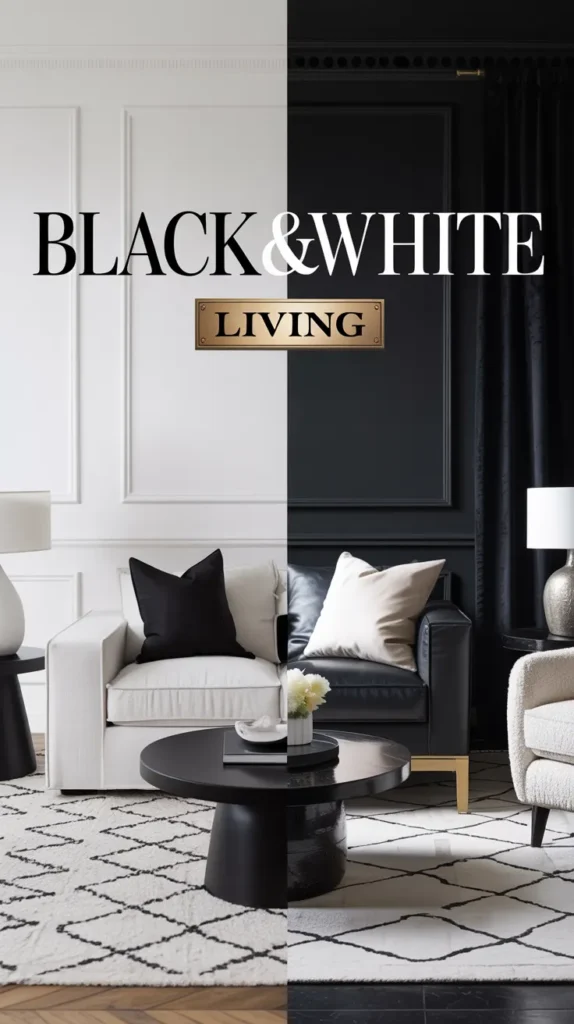
- Choose your dominant color – Most black and white rooms lean heavily toward one or the other. A primarily white room with black accents feels airy and bright, while a mostly black room with white elements feels dramatic and cozy. Pick which vibe speaks to you.
- Start with the big stuff – Walls, floors, and large furniture pieces set the tone. A white sofa against black walls creates instant drama, while black furniture on white walls offers a more subtle contrast.
- Play with patterns – Black and white patterns (stripes, geometrics, florals) add interest without introducing new colors. A patterned rug or throw pillows are perfect low-commitment ways to experiment.
- Don’t forget texture – Without a rainbow of colors, texture becomes even more important. Mix plush fabrics, smooth surfaces, rough textures, and different materials to add depth.
Pro tip: If pure black feels too harsh for your space, try a very dark charcoal or navy that reads as “black” but has a bit more softness and dimension.
French-Style Black and White: Ooh La La Elegance
French-inspired black and white living rooms exude sophisticated European charm. Think Parisian apartment meets modern comfort—ornate details balanced with clean lines.
The key elements of a French-style black and white living room include:
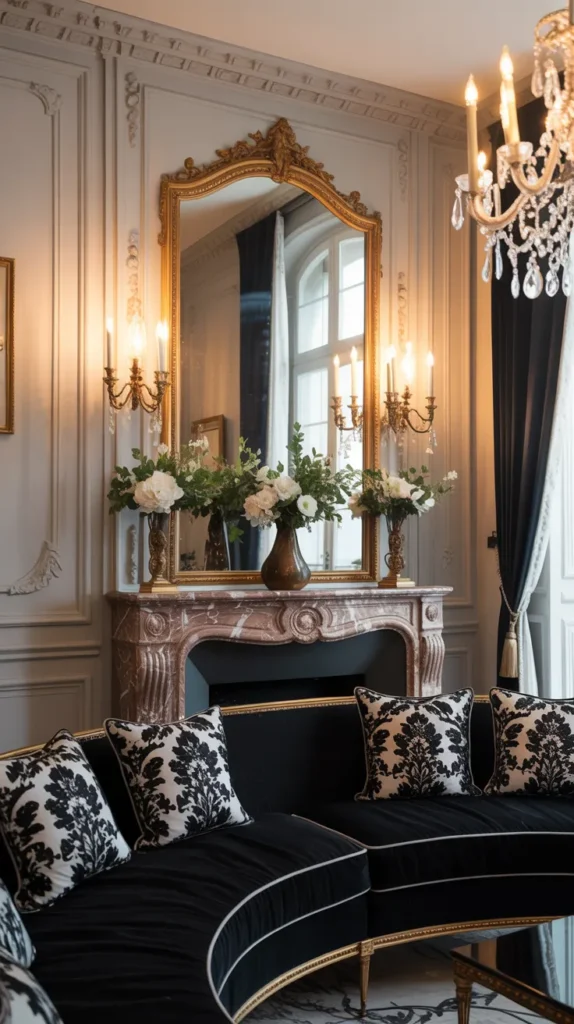
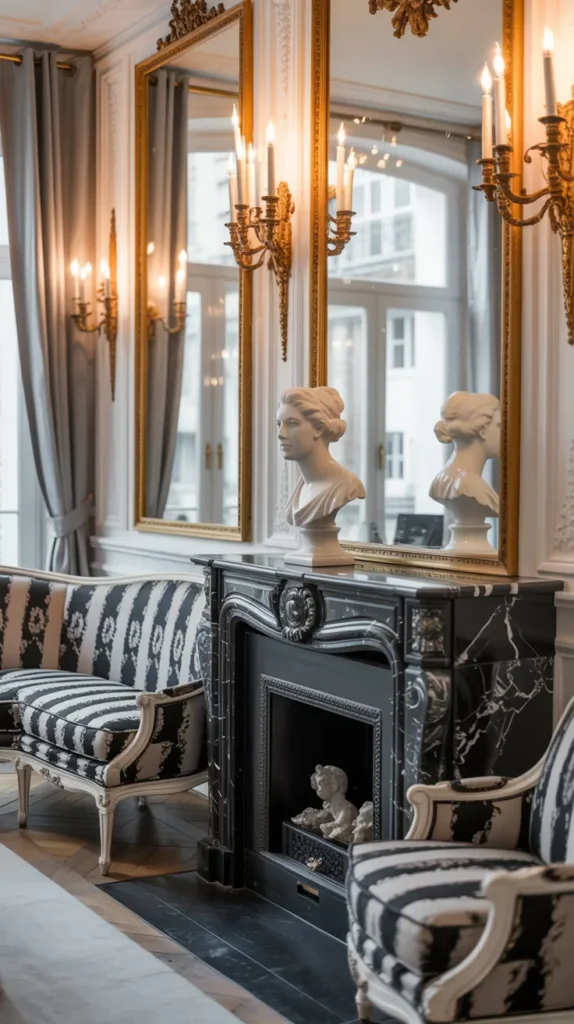
- Elegant furniture with curved lines and details
- Black and white toile or damask patterns
- Crystal chandeliers (black or clear crystal both work beautifully)
- Mirrors with ornate frames
- Touches of gold or silver for a hint of luxury
I’m particularly fond of how French-style rooms manage to feel both formal and comfortable at the same time. There’s an effortlessness to them, even with their more ornate elements. A black marble fireplace surrounded by crisp white walls, or a plush white sofa with black piping—these classic combinations never go out of style.
Bold opinion: Skip the Eiffel Tower décor and “Live, Laugh, Love” signs in French. True French-inspired spaces let the architecture and furnishings speak for themselves.
Scandinavian Black and White: Minimalism With Soul
Scandinavian design and black and white are a match made in heaven. The Nordic approach to interiors already emphasizes clean lines and thoughtful simplicity, which pairs perfectly with a restrained color palette.
A Scandi-inspired black and white living room features:
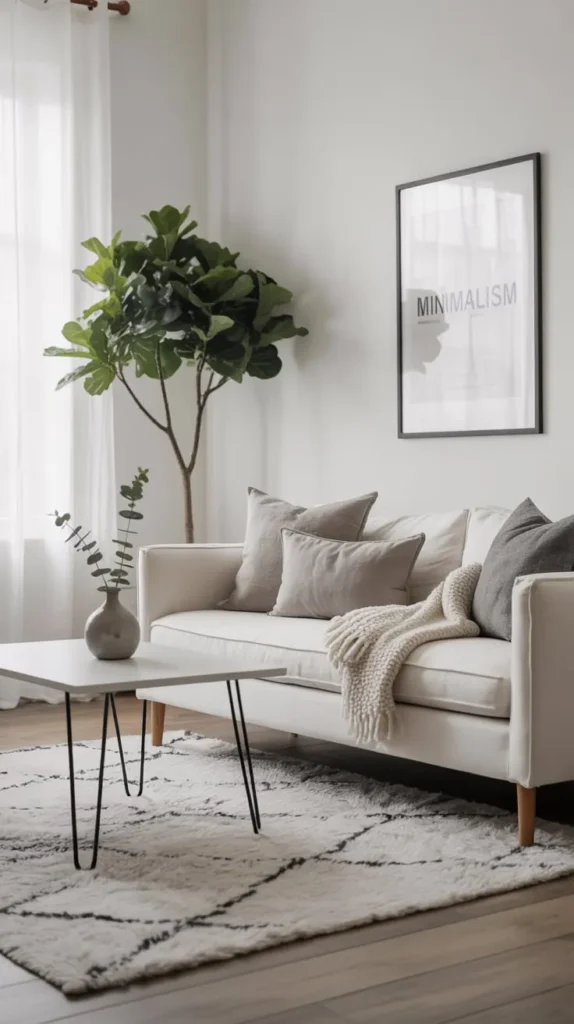
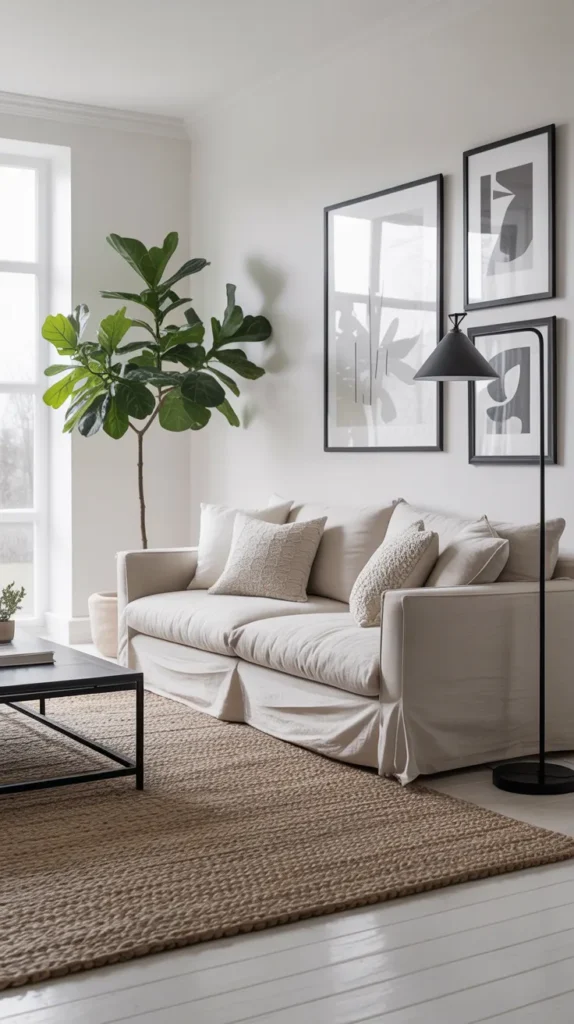
- Predominantly white spaces with strategic black accents
- Natural materials like light wood, wool, and linen
- Minimal but purposeful décor—nothing unnecessary
- Geometric patterns used sparingly
- Excellent lighting (crucial for those dark Nordic winters!)
What saves Scandinavian black and white from feeling cold is the intentional addition of texture and natural elements. A chunky knit throw on a streamlined sofa, a sheepskin draped over a black chair, or a cluster of white ceramic vases in various shapes—these details add soul to spaces that might otherwise feel too sparse.
I recently helped a friend revamp her living room using Scandinavian black and white principles. The transformation was incredible—suddenly her average-sized room felt twice as large, and the simplified color scheme made her few treasured décor pieces stand out beautifully.
Wabi-Sabi Black and White: Finding Beauty in Imperfection
If you’re drawn to spaces with history and character, a Wabi-Sabi approach to black and white might be your perfect match. This Japanese philosophy embraces imperfection and finds beauty in the authentic and weathered.
A Wabi-Sabi black and white living room incorporates:
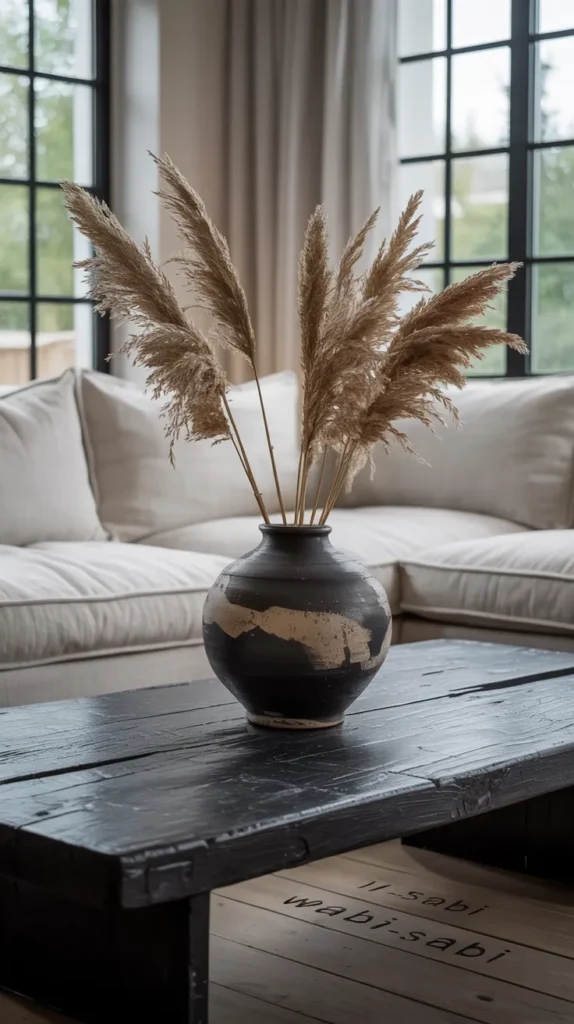
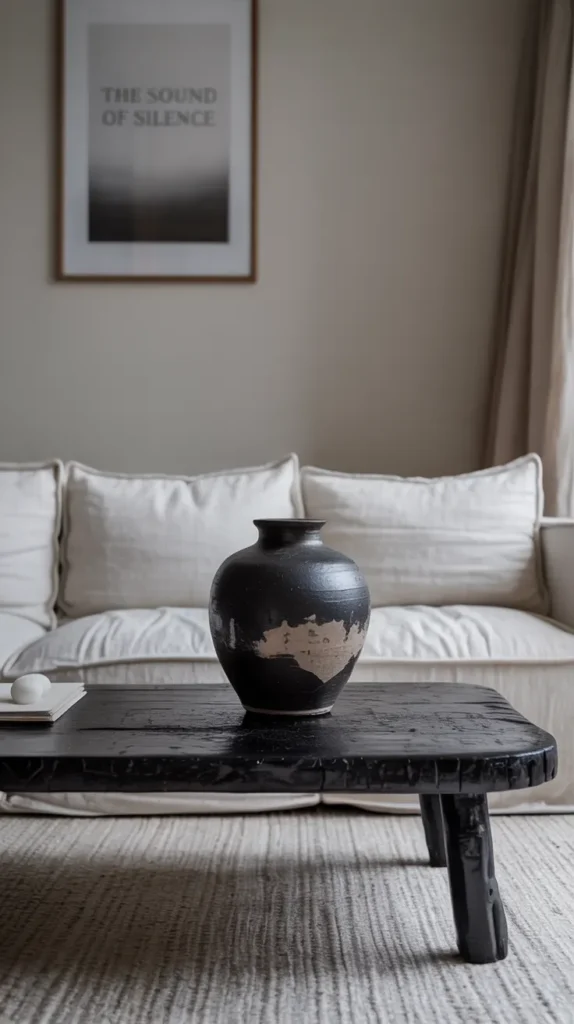
- Varied shades of black, white and gray—nothing too perfect or stark
- Natural, often handcrafted materials with visible texture
- Irregular patterns and organic shapes
- A sense of history and subtle weathering
- Minimalism, but with warmth and character
What I love about Wabi-Sabi black and white spaces is how they remind us that “perfect” isn’t always interesting. A slightly uneven handmade black ceramic vase, a wrinkled white linen sofa cover, or a weathered black wooden coffee table all bring character that mass-produced perfection simply can’t match.
This approach feels especially suited to older homes or for people who want to incorporate antiques and vintage pieces into their living spaces. The black and white palette unifies diverse elements, while the Wabi-Sabi philosophy celebrates rather than hides the marks of time and use.
Art Deco Black and White: Glamour on High Contrast
For those who want their living room to make a statement, Art Deco-inspired black and white creates undeniable drama. This style from the 1920s and 30s embraces bold geometry, luxury materials, and unapologetic glamour.
The hallmarks of an Art Deco black and white living room include:
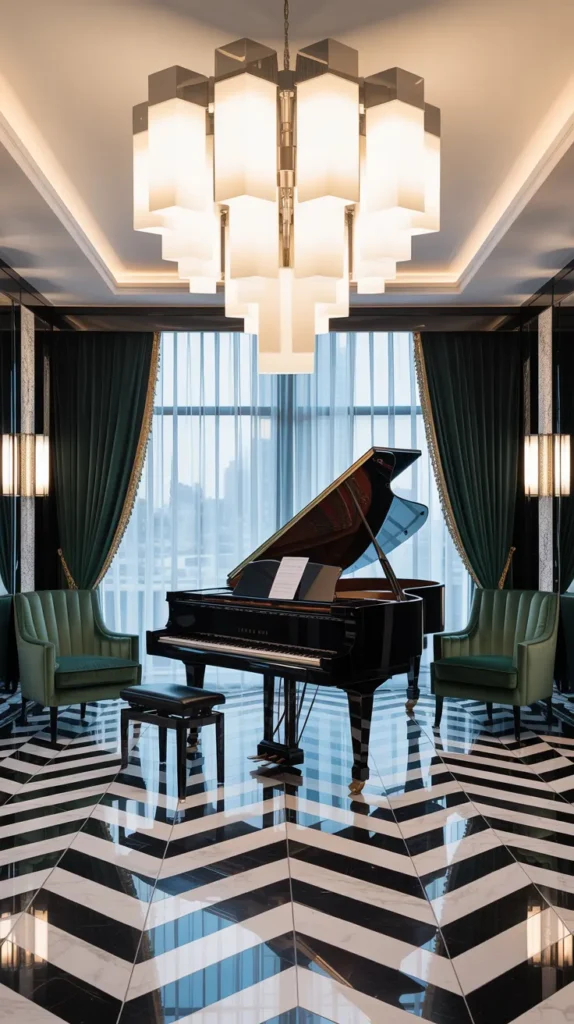
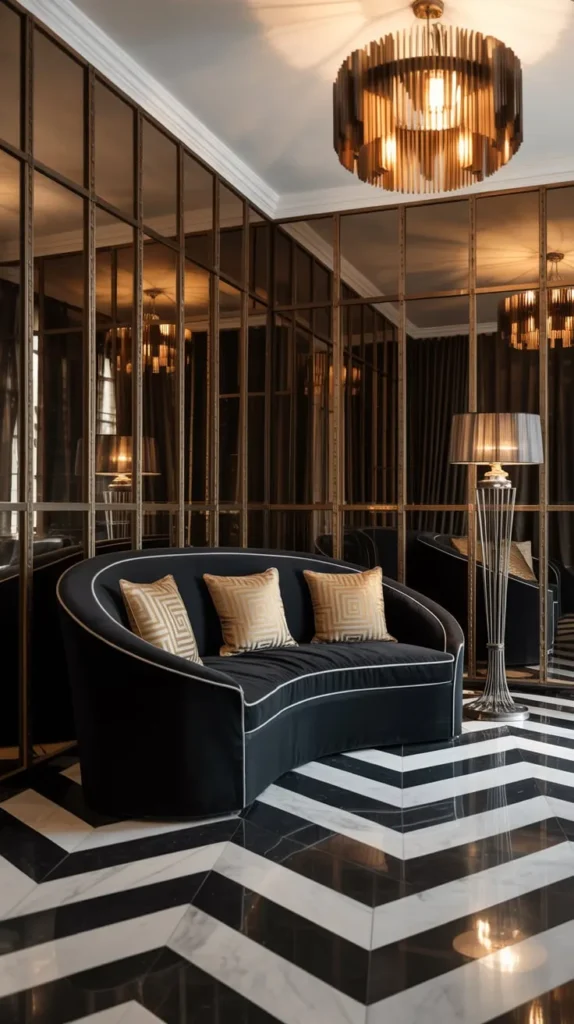
- Strong geometric patterns and symmetry
- High-contrast black and white used in bold ways
- Mirrored and metallic surfaces (chrome, brass, or gold)
- Luxurious materials like velvet, marble, and lacquer
- Statement lighting (especially chandeliers and sconces)
Art Deco black and white isn’t trying to be subtle—it’s designed to impress. A black lacquered coffee table atop a bold geometric black and white rug. A white sofa with black velvet pillows flanked by mirrored side tables. Wall sconces with frosted glass and black metal details. These combinations create spaces that feel cinematic and glamorous.
This style works particularly well in apartments and urban spaces where the architecture already has some Art Deco influence. However, even in a standard suburban home, you can create an Art Deco-inspired space that feels like a set from “The Great Gatsby.”
Vintage Black and White: Nostalgic Charm
There’s something incredibly charming about vintage-inspired black and white living rooms. They feel collected over time rather than ordered from a catalog, with personality in every corner.
A vintage black and white living room often features:
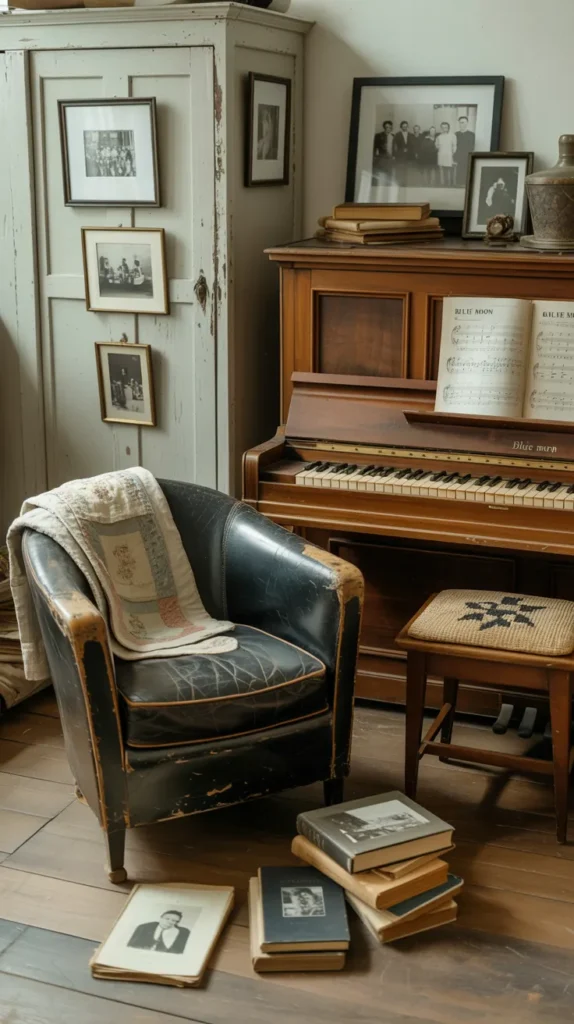
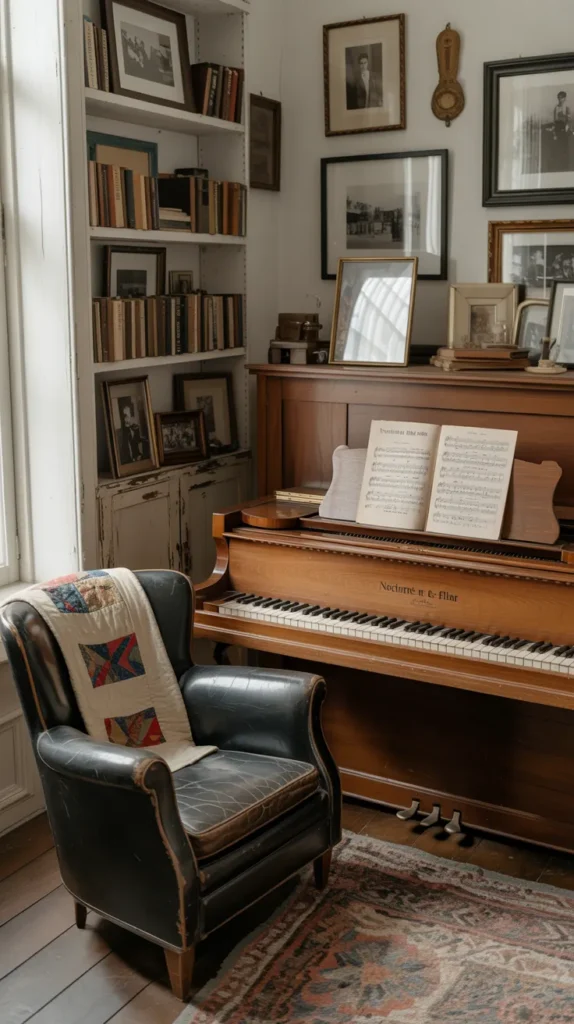
- Antique or vintage furniture pieces with character
- Black and white photographs or vintage art
- Patterns inspired by different eras (Victorian florals, 50s atomic prints)
- A mix of different wood tones alongside the black and white
- Vintage textiles like handmade quilts or needlepoint pillows
The beauty of vintage black and white is that it doesn’t need to commit to a specific era. You can mix a Victorian-inspired black velvet settee with mid-century modern black and white photography and still achieve a cohesive look. The limited color palette unifies pieces from different periods in a way that feels intentional rather than chaotic.
I have a soft spot for vintage black and white living rooms that incorporate family heirlooms and treasured finds. A black piano passed down through generations, or a collection of white milk glass displayed on a black painted bookshelf—these personal elements tell your story in a visually cohesive way.
Elegant Black and White: Timeless Sophistication
For those who appreciate refined, sophisticated spaces, an elegant black and white living room offers timeless appeal. This approach focuses on quality over quantity, with careful attention to proportion and scale.
An elegant black and white living room typically includes:
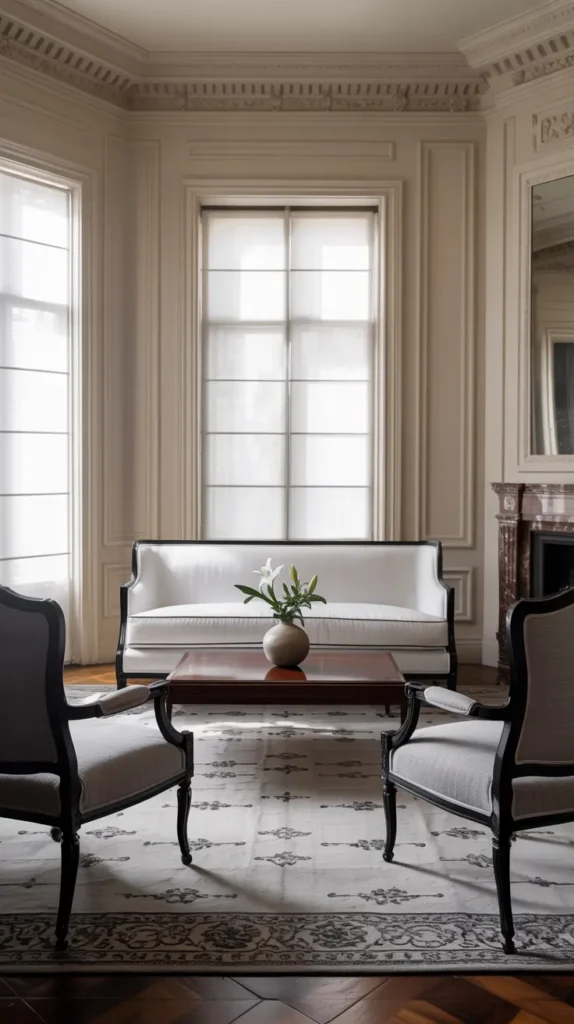
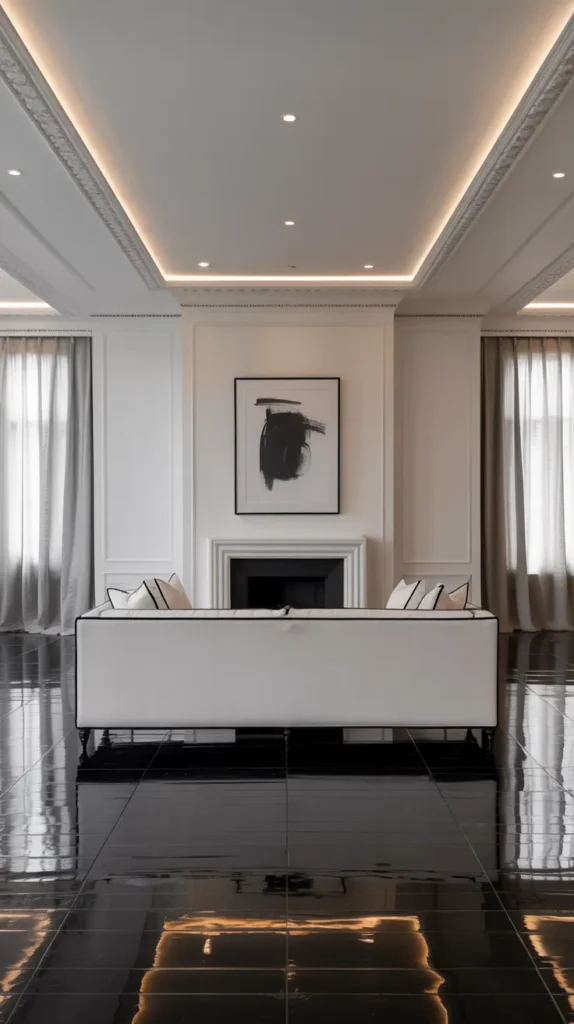
- High-quality furniture with classic lines
- A restrained approach to patterns and accessories
- Thoughtful symmetry and balance
- Fine materials like silk, wool, and polished wood
- Architectural details highlighted by the contrasting colors
What distinguishes truly elegant black and white spaces is their sense of restraint. Rather than filling every surface, these rooms allow each carefully chosen element room to breathe. A stunning black grand piano against a white wall. A pair of matching white armchairs with tailored black piping. A single large-scale black and white photograph above a fireplace. These focused moments create impact without clutter.
I find that elegant black and white spaces age particularly well. Because they’re not chasing trends, they tend to look just as good a decade later as they did the day they were designed.
Boho Chic Monochrome: Free-Spirited Contrast
If you think black and white has to be rigid or formal, think again! Boho chic takes this color scheme and infuses it with a relaxed, collected, free-spirited vibe that feels both contemporary and timeless.
A boho chic black and white living room embraces:
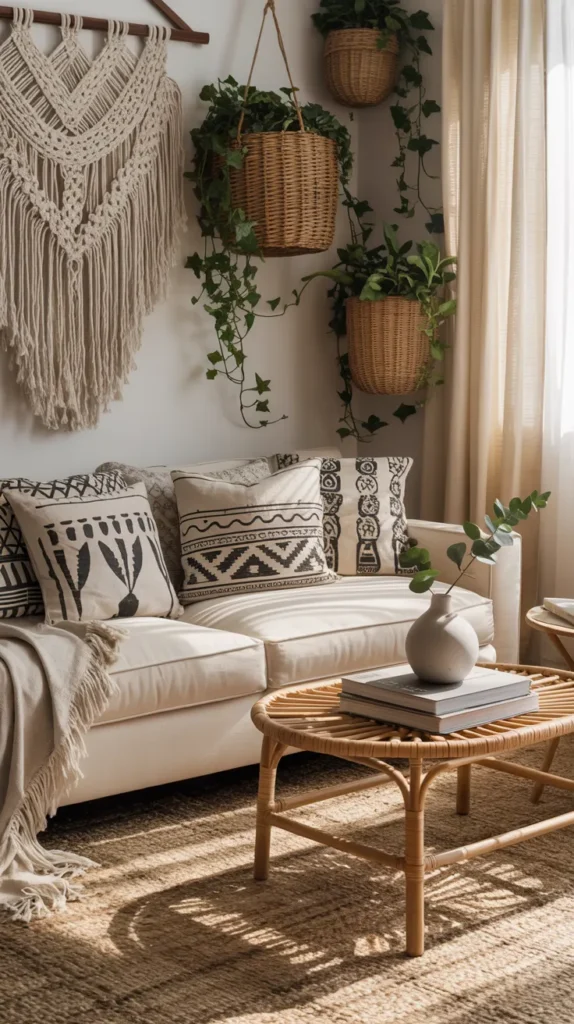
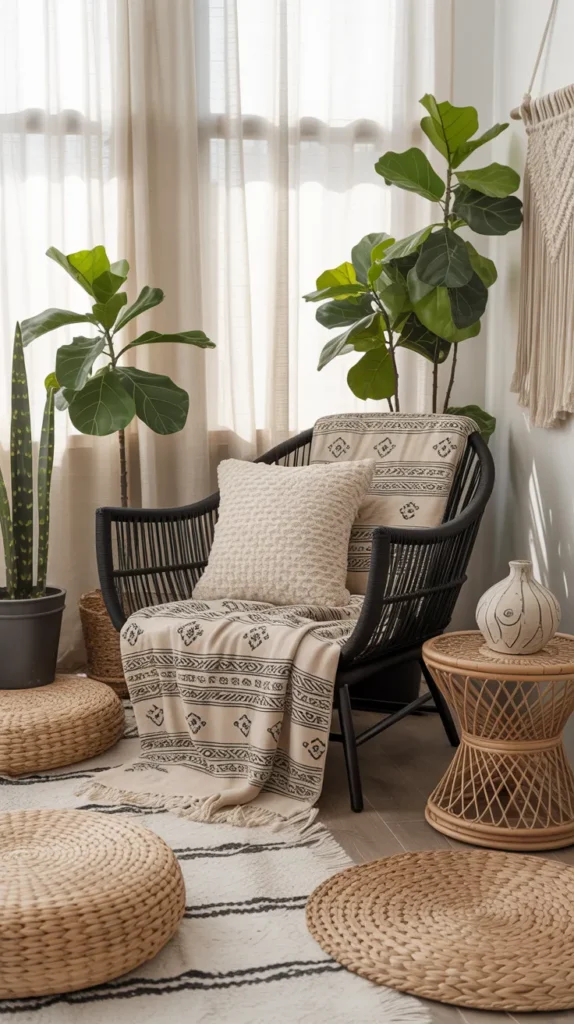
- Layered textiles with varied patterns and textures
- A mix of cultural influences and global elements
- Plants and natural materials that add life and warmth
- Handcrafted items with personality and character
- A relaxed, unfussy approach to arrangement
What I love about boho black and white is how it maintains the graphic punch of high contrast while feeling completely approachable and lived-in. Imagine a low-slung white sofa piled with black and white patterned pillows from different parts of the world. A black rattan chair paired with a shaggy white sheepskin throw. White walls adorned with black-framed botanical prints and macramé wall hangings.
This style works particularly well for people who love to collect things on their travels or who want a space that can easily evolve over time. The black and white foundation keeps the eclectic mix feeling intentional rather than chaotic.
Modern American Black and White: Comfortable Contrast
Modern American style prioritizes comfort and practicality while still looking pulled together—and in black and white, it creates spaces that feel both contemporary and inviting.
A modern American black and white living room typically features:
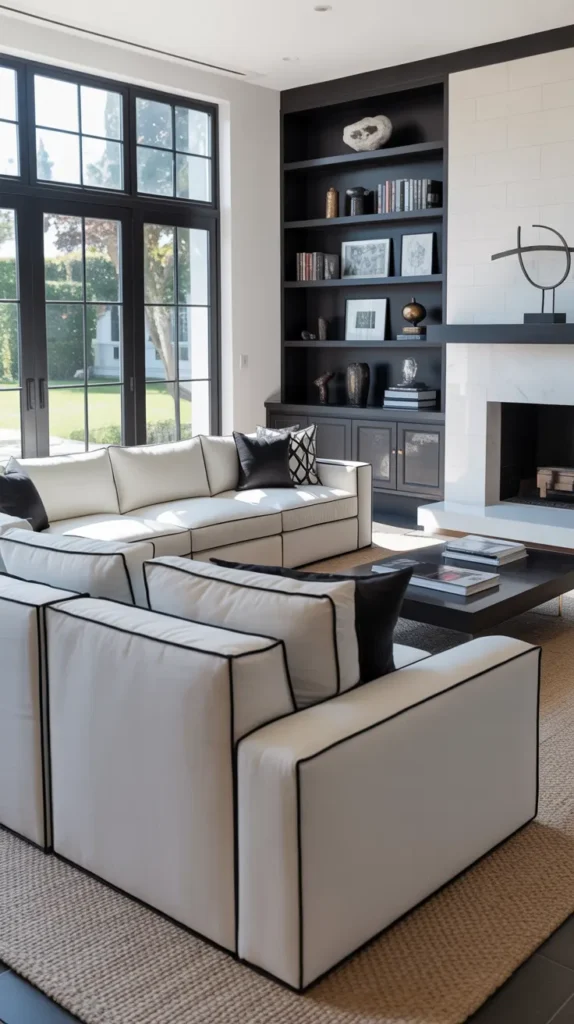
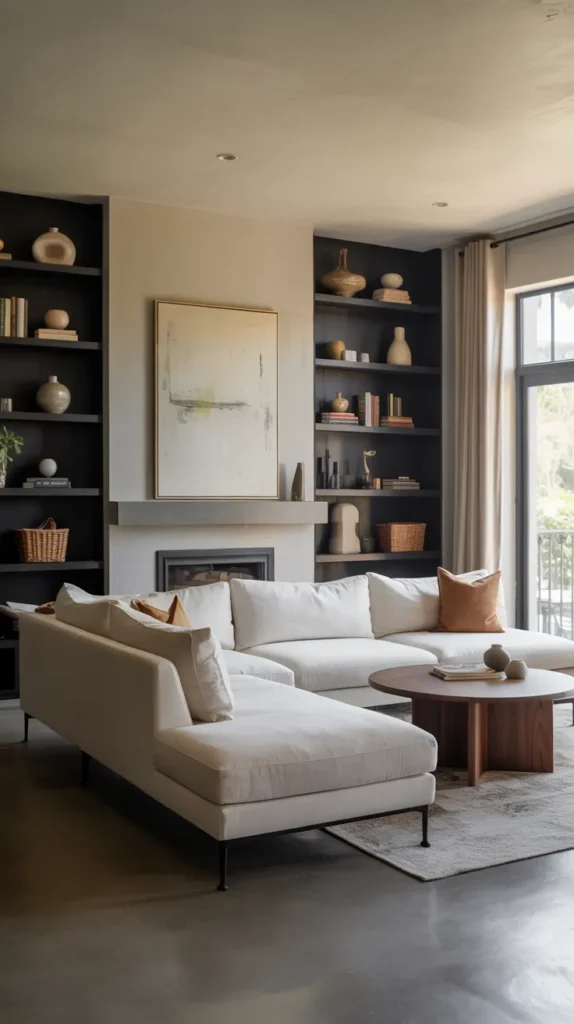
- Comfortable, generous seating (often a sectional sofa)
- Clean lines without being rigidly minimal
- A mix of materials that add visual interest
- Practical storage solutions incorporated into the design
- A balance of form and function
The modern American approach to black and white feels fresh without trying too hard. Think white walls with black-framed windows. A plush charcoal sectional topped with white pillows. Black metal and wood bookshelves displaying a mix of books, white ceramics, and personal mementos.
This style is particularly well-suited to families and everyday living because it prioritizes durability and comfort alongside aesthetics. Slipcovers, performance fabrics, and easily cleaned surfaces make these high-contrast spaces practical for real life.
Maximalist Black and White: Bold Drama Without Color
Who says black and white has to be minimal? Maximalist black and white living rooms prove that you can embrace abundance and drama without a rainbow of colors.
A maximalist black and white living room goes all in with:
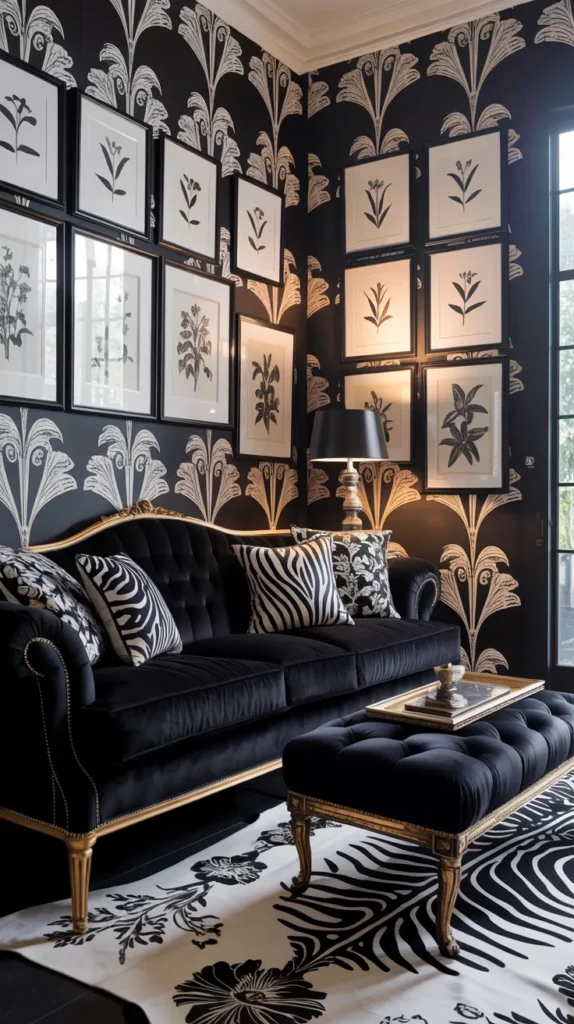
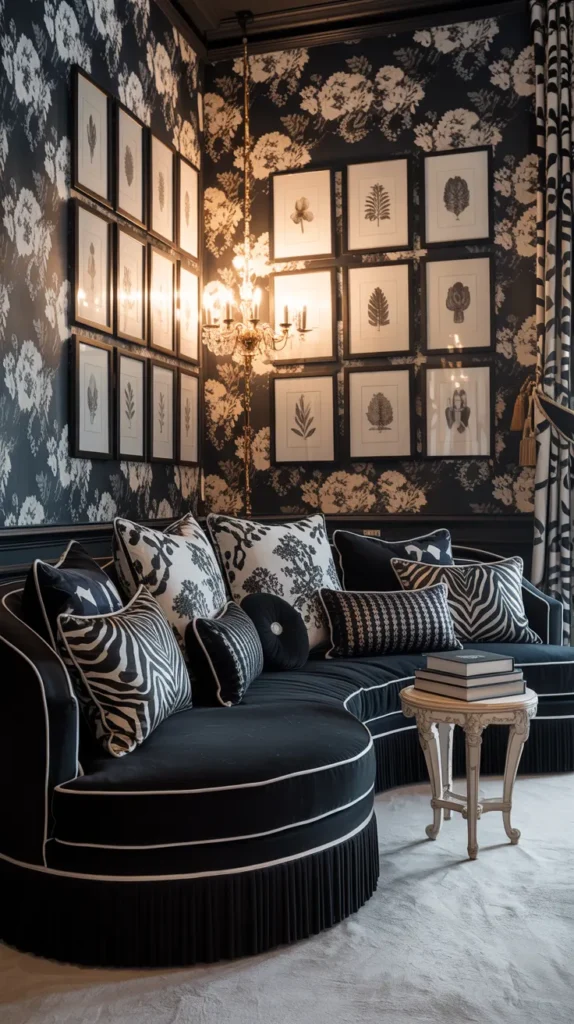
- Multiple patterns in varying scales (stripes, florals, geometrics)
- Layers upon layers of textiles and textures
- Statement furniture pieces that demand attention
- Gallery walls or large-scale art installations
- Collections displayed en masse rather than as single objects
What makes maximalist black and white spaces work is the underlying discipline of the limited color palette. You can mix patterns that would clash in color but harmonize perfectly in black and white. A zebra print rug beneath a sofa upholstered in bold black and white stripes, topped with damask and floral pillows—sounds like a lot, but in monochrome, it works!
I find these spaces particularly successful when they incorporate subtle variations in tone—soft whites, deep charcoals, silver grays—that add dimension to the high-contrast scheme.
Midcentury Modern Black and White: Retro Contrast
Midcentury modern design with its clean lines and organic curves takes on a graphic, almost artistic quality when rendered in black and white.
A midcentury modern black and white living room features:
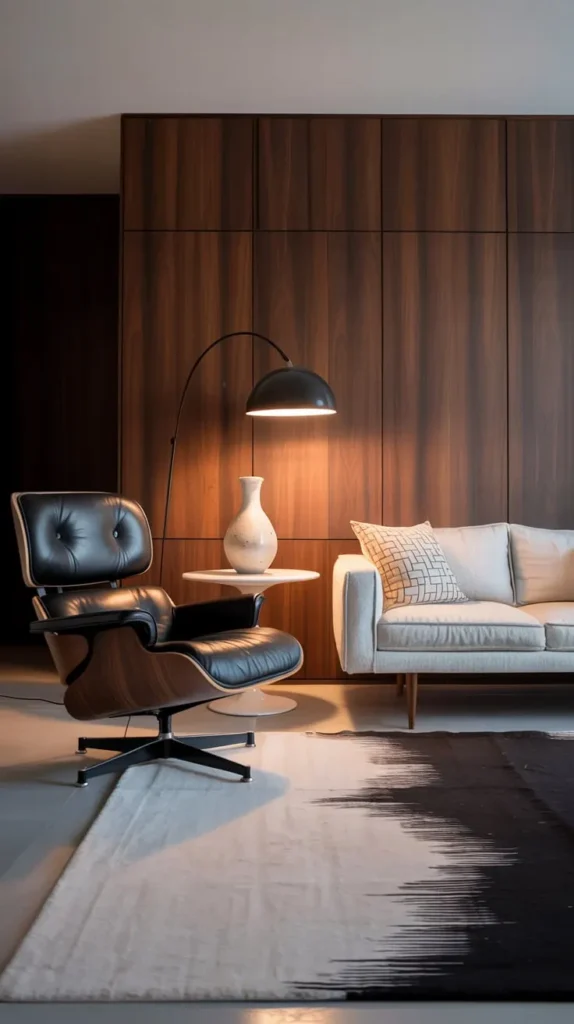
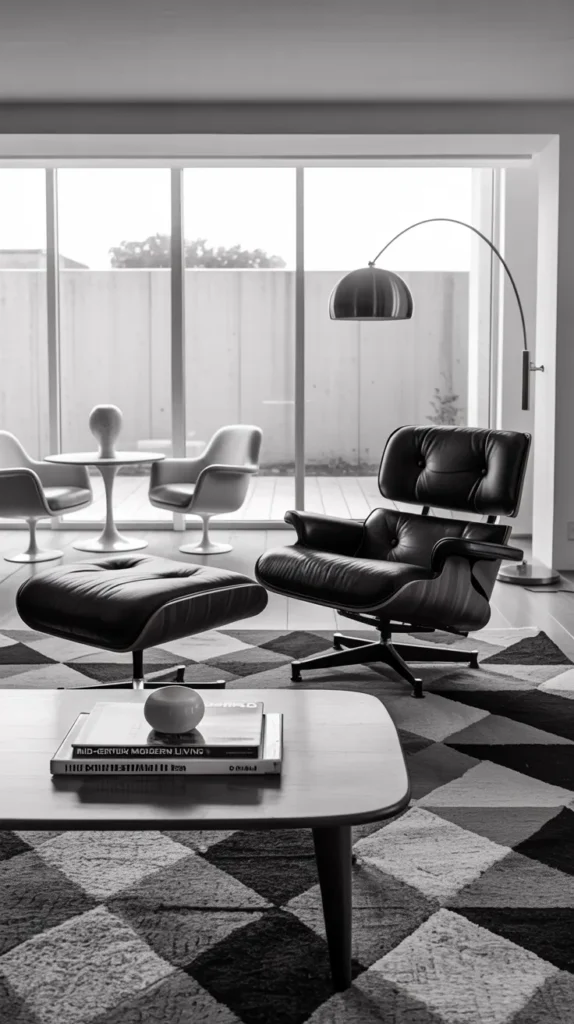
- Iconic furniture silhouettes from the 1950s and 60s
- A careful balance of black and white with wood tones
- Geometric patterns that echo the era
- Statement lighting as functional sculpture
- A curated, intentional look that references the past without being stuck in it
The beauty of midcentury black and white is how it highlights the incredible shapes and forms that defined this design era. A black Eames lounge chair stands out dramatically against white walls. A white tulip table base creates a sculptural moment in front of a black accent wall. These high-contrast combinations celebrate the inherent design genius of midcentury pieces.
For those who appreciate this style but don’t want to commit to a fully retro look, black and white allows you to incorporate midcentury elements into a more contemporary space without creating a time warp effect.
Making It Work: Tips for Living With Black and White
If you’re inspired to try black and white in your own living room, here are some practical tips I’ve learned through many design projects:
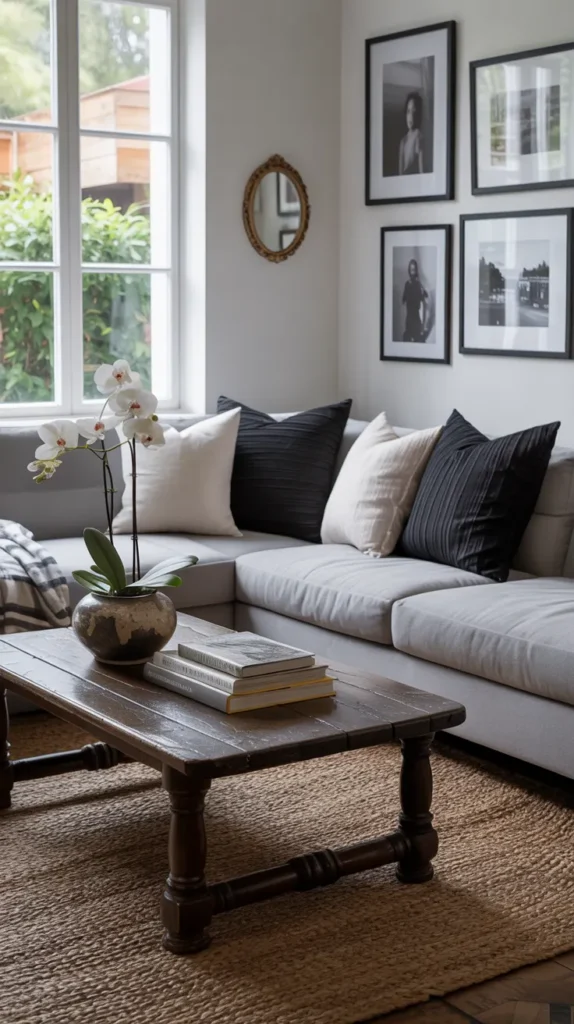
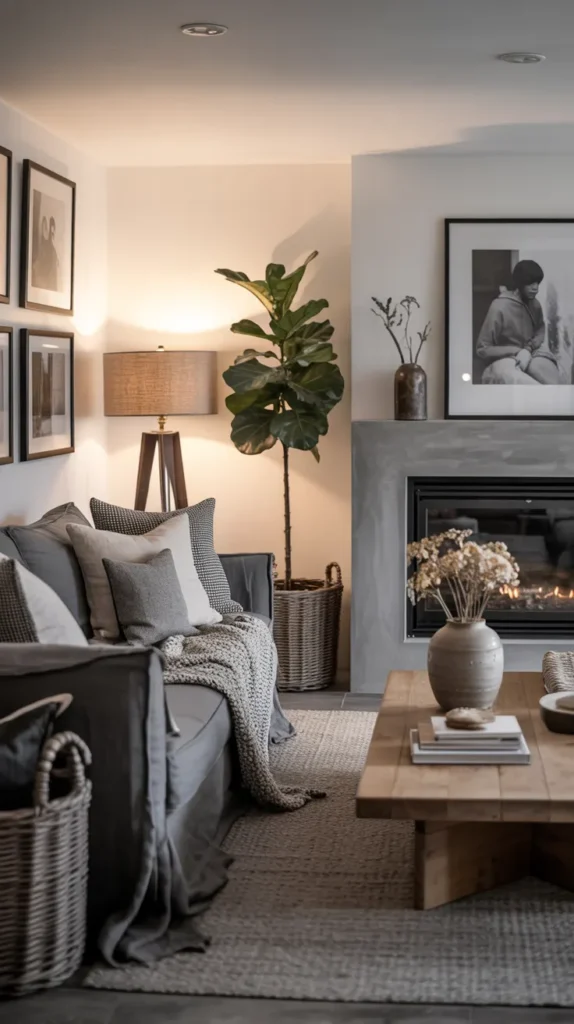
- Consider your lighting – Black absorbs light while white reflects it. If your space gets limited natural light, you might want to lean more heavily toward white with black accents rather than the reverse.
- Don’t forget warmth – Incorporate natural materials like wood, leather, or plants to keep the space from feeling cold or stark.
- Embrace texture – Without many colors, texture becomes even more important for creating visual interest and depth.
- Use different tones – Pure black and stark white can feel harsh together. Consider soft whites, off-whites, charcoals, and deeper blacks for more dimension.
- Start small – If you’re nervous about committing, begin with a black and white rug or artwork, then gradually build from there.
Remember, there are no rigid rules—the best black and white living room is one that feels right to you. Whether you go all-in with high drama or create a more subtle interpretation, this classic combination offers endless possibilities for creating a space that’s both timeless and thoroughly personal. ✨

